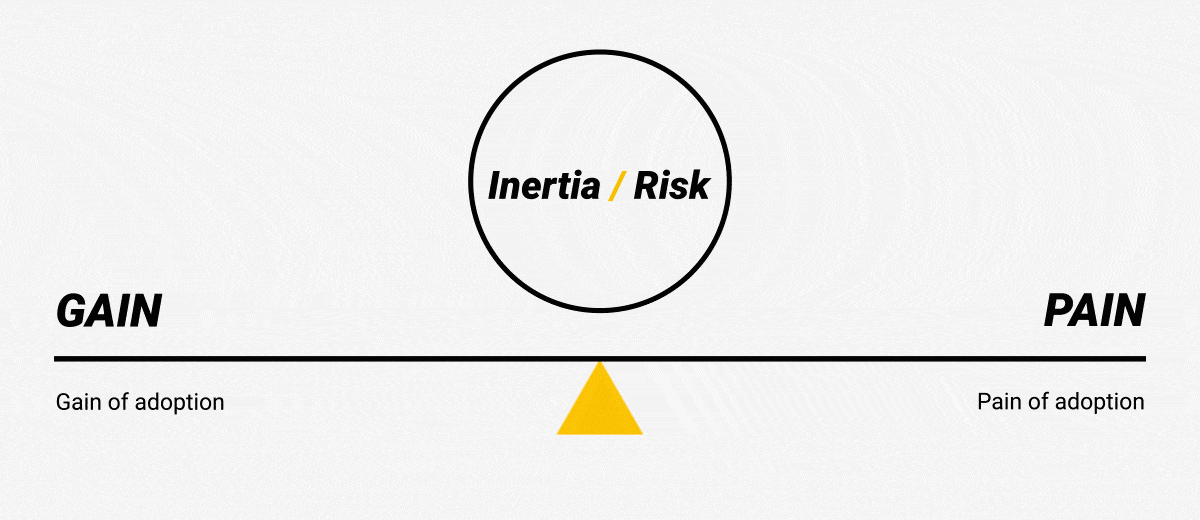There are plenty of high-potential founders out there, but many entrepreneurs lose out because they never truly articulate a compelling value proposition. Establishing a substantive value proposition is critical if you want to start the journey from your “idea” to building a successful company.
In its simplest terms, a value proposition is like a positioning statement that explains what benefit you provide for who and how you do it uniquely well. It describes your target buyer, the problem you solve, and why you’re distinctly better than the alternatives.
In this video, Underscore VC Partner Chris Gardner shares some more context around what investors look for in a value prop.
As you set out to learn how to write a value proposition, consider the following four steps: Define, Qualify, Evaluate, and Measure:
1. Define the Problem to Determine if it’s Worth Solving
Charles Kettering, the inventor, is famous for saying, “A problem well stated is a problem half solved.” Can you clearly state the problem you’re solving? Don’t make the mistake of diving head-first into a solution before you really understand the problem you’re trying to tackle.
A significant part of defining a value proposition involves what Underscore calls the 4Us. If you find yourself answering a definitive yes to the majority of these questions, then you’re on the right track. If not, consider re-evaluating and revising your new venture.
- Is the problem Unworkable? Does your solution fix a broken business process where there are real, measurable consequences to inaction? Will someone get fired if the issue is not addressed?
- Startup Secret: If the answer is yes, then that person will likely be your internal champion.
- Is fixing the problem Unavoidable? Is it driven by a mandate with implications associated with governance or regulatory control? For example, is it driven by a fundamental requirement for accounting or compliance?
- Startup Secret: If the answer is yes, then that group will likely be a champion.
- Is the problem Urgent? Is it one of the top few priorities for a company? In selling to enterprises, you’ll find it hard to command the attention and resources to get a deal done if you fall below this line.
- Startup Secret: If the answer is yes, then you know you’ll have the attention of the c-suite.
- Is the problem Underserved? Is there a conspicuous absence of valid solutions to the problem you’re looking to solve? Focus on the whitespace in a market or segment.
- Startup Secret: If the answer is yes, then you know the market is primed for the solution.
2. Qualify the Problem: Is it “BLAC and White?”
Is it BLAC (Blatant, Latent, Aspirational, Critical) and does it address a WHITE space in the market, allowing you to capitalize on an open area of opportunity?

In B2B technology markets, you want to address problems that are Blatant and Critical, as they are far more acute than those that are Latent and Aspirational. Blatant and Critical problems stand in the way of business. They put careers and reputations at risk. Latent problems are unacknowledged, which means they often require costly missionary selling. Aspirational problems are optional, which is the hardest of places for a B2B startup to sell.
Consider Coda and its value proposition. The company is building “a new doc that brings words, data, and teams together.” From launching products to planning marketing campaigns to making information accessible, Coda makes it easy for teams to collaborate, get organized, and get work done.
It should be noted that many successful B2C products are based on exposing latent aspirational needs. Facebook is a great example. Think about Maslow’s hierarchy of needs. You can see how social needs might have driven Facebook’s success.
3. Evaluate Whether Your Breakthrough is Unique and Compelling
After you determined the problem you’re solving and validated its criticality, ask yourself: What is unique and compelling about your breakthrough?
A useful approach is to think of your breakthrough in the context of the 3Ds: What unique combination of discontinuous innovation, defensible technology, and disruptive business model are you bringing to bear and what makes it truly compelling—not just to you and your colleagues, but to your most skeptical customer?
- Discontinuous innovations offer transformative benefits over the status quo by looking at a problem differently.
- Defensible technology offers intellectual property that can be protected to create a barrier to entry and unfair competitive advantage.
- Disruptive business models yield value and cost rewards that help catalyze the growth of a business.
Simply having a product or service that is faster, cheaper, and better is not enough to make it compelling, but evaluate it in 3D and you can really open up the potential for a breakout.
4. Measure Potential Customer Adoption Using the Gain/Pain Ratio
Most entrepreneurs are so focused on the features they deliver, they forget to examine how hard it will be for customers to learn to use their product. So the Gain/Pain ratio involves measuring the gain you deliver the customer vs. the pain and cost for the customer to adopt.

If you can’t deliver a 10x gain of adoption/pain of adoption, customers will typically default to inertia and will “do nothing” rather than bear the risk of working with you.
As investors, we look for non-disruptive disruptions: technologies that offer game-changing benefits with minimal modifications to existing processes or environments. Simply put: disruptive innovation would ideally be non-disruptive to adopt.
Non-disruptive is critical to startups since the gain you deliver will also be discounted by the risk associated with betting on you as a young company. A successful venture delivers an order of magnitude improvement over the status quo. If you can’t deliver a 10x gain/pain promise, customers will typically default to “do nothing” rather than bearing the risk of working with you.
How to Write a Value Proposition
Once you have gone through the defining, qualifying, evaluating, and measuring steps, you are ready to write your value proposition. This next outline is not original—it’s typical of positioning statements to be consistent and reusable as such:
- For (target customers)
- Who are dissatisfied with (the current alternative)
- Our product is a (new product)
- That provides (key problem-solving capability)
- Unlike (the product alternative).
That’s how to write a value proposition, but there’s one more important piece: you!
Don’t lose sight of the fact that you are core to your venture’s value proposition. What problems do you understand uniquely well? What solution can you deliver uniquely well? What kind of disruptive business model can you bring? Be true to yourself as a thought leader and you will go far.










